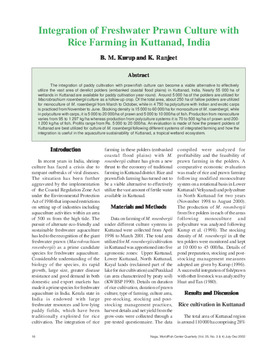Integration of freshwater prawn culture with rice farming in Kuttanad, India
Abstract
The integration of paddy cultivation with prawn/fish culture can become a viable alternative to effectively utilize the vast area of derelict polders (embanked coastal flood plains) in Kuttanad, India. Nearly 55 000 ha of wetlands in Kuttanad are available for paddy cultivation year-round. Around 5 000 ha of the polders are utilized for Macrobrachium rosenbergii culture as a follow-up crop. Of the total area, about 250 ha of fallow polders are utilized for monoculture of M. rosenbergii from March to October, while in 4 750 ha polyculture with Indian and exotic carps is practiced from November to June. Stocking density is 15 000 to 60 000/ha for monoculture of M. rosenbergii, while in polyculture with carps, it is 5 000 to 20 000/ha of prawn and 5 000 to 10 000/ha of fish. Production from monoculture varies from 95 to 1 297 kg/ha whereas production from polyculture systems it is 70 to 500 kg/ha of prawn and 200 - 1 200 kg/ha of fish. Profits range from Rs. 5 000 to 20 000/ha. An evaluation is made of how the present polders of Kuttanad are best utilized for culture of M. rosenbergii following different systems of integrated farming and how the integration is useful in the aquaculture sustainability of Kuttanad, a tropical wetland ecosystem

